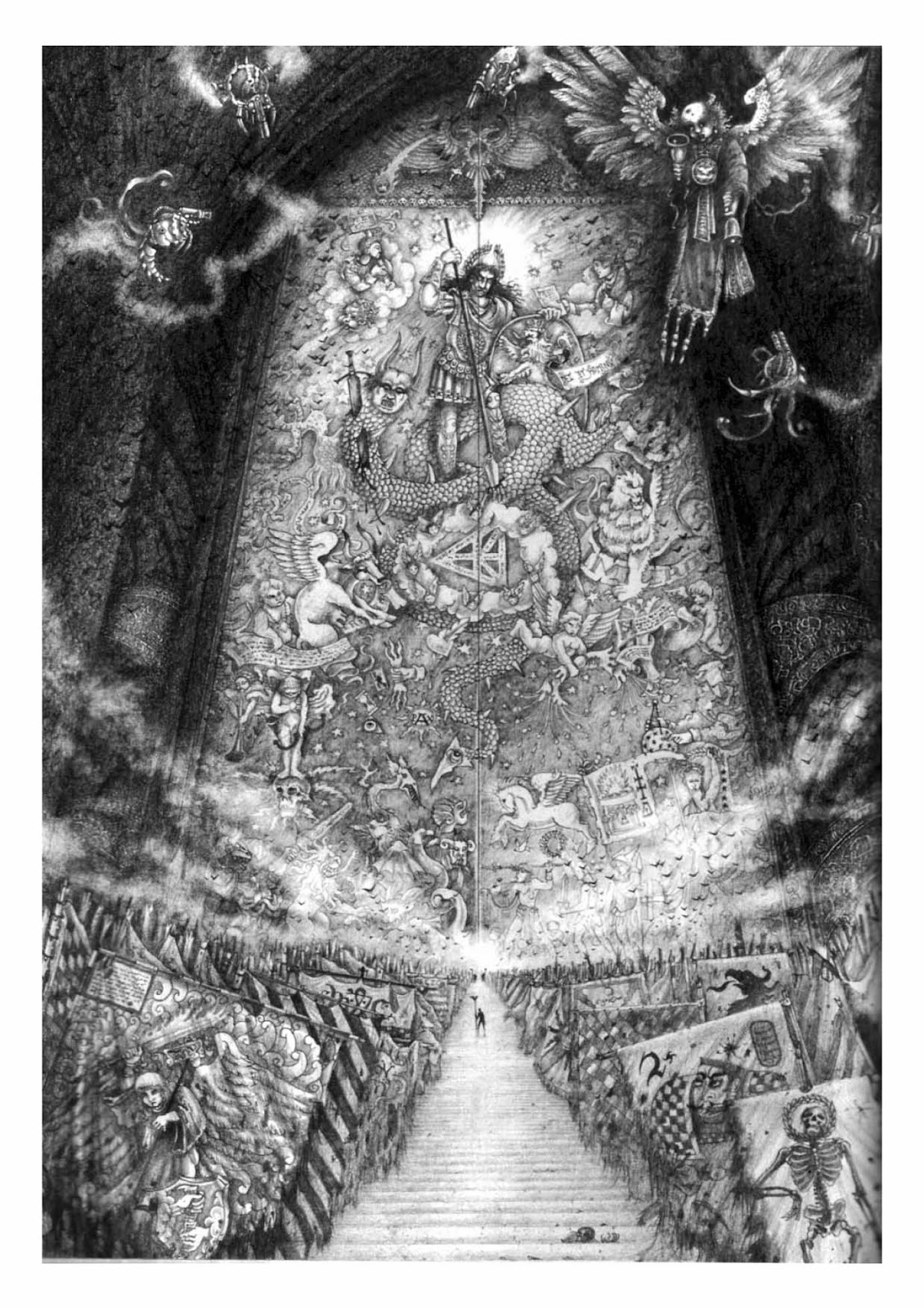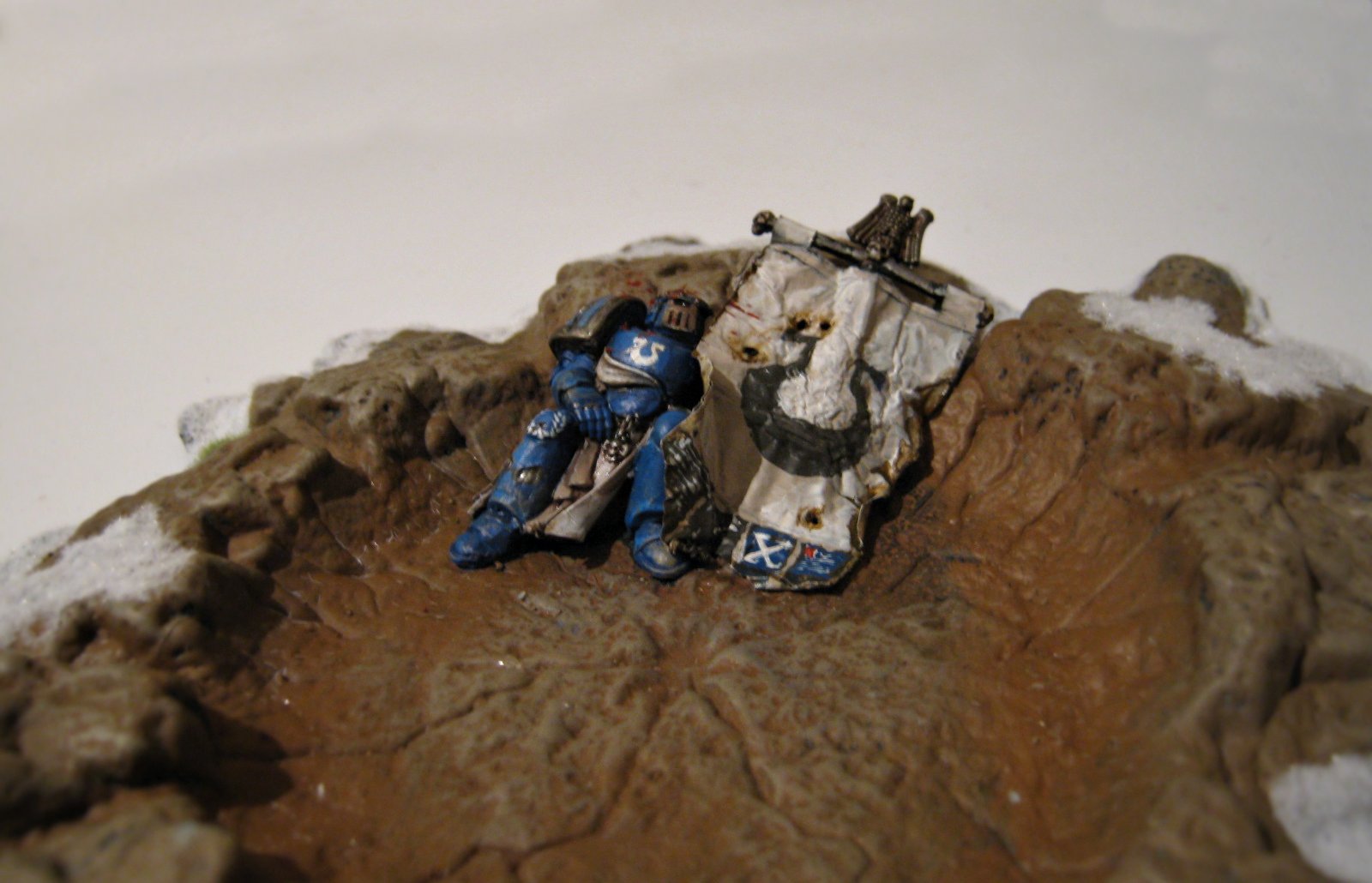+ inload: Mark of Calth +
+ Here are the three figures from the front cover, Captain Ventanus, Sergeant Selaton (the mournful-looking chap with the banner) – oh, and Brother Genericus, third spear carrier to the left.
+ I'm very pleased with how they've come out – it was a real pleasure to just sit down and enjoy modelling and painting. I enjoy the challenge of finding the right bits and pieces for the models, and adapting existing parts with conversion work. +
+ I think the challenge isn't so much reproducing things perfectly as getting the tone across. The artistic interpretation is a big part of the fun – will that set of legs work if I trim away the detail and add a kneepad? What head do I use as the basis for that eagle-winged helm? Am I going to model that detail, or use paint to suggest it? – and so forth. +
+ Following are some detail shots or the individual marines, along with a few notes or thoughts. +
+ Captain Ventanus +
+ The 'main man' of the artwork, Ventanus had to be the focus of my effort, so I started with him. Ventanus was relatively straightforward to plan and build. The distinguishing (iconic) features I spotted looking at the artwork were the overall pose, the bare head and the unusual spiked pauldron. The head is an important part – and usually a focal point – of any figurative work.
+ After rummaging through my bits box, I chanced upon a head from the Scout biker set. The plastic Scouts are fairly notorious for having blocky, ugly heads; but after a closer look, I thought that there was some potential there. In any case, the biker scouts are a little more promising than the foot version, with slightly better definition. I trimmed away the microphone across his jaw and filed it back to give the head the prominent jawline of Roberts' artwork. Similarly, I trimmed back the earpiece to make it more subtle, and softly filed back the head above the ears to give Ventanus his short-back-and-sides 'do, and reduce the slight bulging inherent to a two-part plastic head. This gave a good base for some heavy tonal work with the paints that adds the drama to the original artwork. +
+ I picked a set of legs from the Sons of Horus Justaerin set, as these came with spikes on and a heavy belt. I trimmed away the spikes and glued them on to the pauldron, starting from the centre – always a good idea on symmetrical devices!
+ The artwork shows the Captain with angular gold-trimmed kneepads. Because of the way I was intending to do the metallics, I needed some structure, so I carefully trimmed the reinforcing rims on the original legs to reshape the kneepad. Similarly, I trimmed away the Eye of Horus on the belt, leaving a nice space to add the decorative belt. These detail is not – in my opinion – vitally important to the character, so this could easily have been done another way, perhaps using a different set of legs; or equally, left off altogether. +
+ Neil Roberts' artwork has some script or iconography on the pauldron, just above the trim, and also a Legion symbol with a grenadier device (a bomb, looking a little like a pineapple) on the knee. These were fun little details to add – the Grenadier guards are an elite British army regiment, so it's nice to suggest the symbol still symbolises duty and honour in the far future. +
+ Ventanus' right-hand side is hidden from view in the artwork, but needs to be considered in a three-dimensional model. I opted to add a sidearm (the magazine and muzzle is visible behind his arm) and some iconography to the pauldron in the form of the Legion symbol. Taking inspiration from the grenadier device on the knee, I included it in the Legion symbol as an honorific. I also added 'IV' at the bottom, as Ventanus is mentioned in the story as Captain of the 'troublesome' Fourth company. +
+ This view highlights a few divergences from the artwork – namely the colour of the backpack and the looped armour on the back of his legs. I've always interpreted the bits which come off the top of the backpack to be heat vents or thrusters, so I have painted them metallic since I was a nipper. While this model is for a specific purpose, I'd also like him to fit in with the rest of my Ultramarines, so I decided such a minor change was perfectly fine – after all, he's my interpretation of the artwork, so I want some design flourishes of my own! +
+ Not much to draw attention to here, except that you can see the unusual gold trim on the hands and the decorated gold forearm piece. This is a good example of making concessions to size. The original artwork has the forearm covered with delicate filigree. To get a similar effect at this size, I stippled a lighter metallic over the base colour before applying the wash that creates the gold. +
+ Sergeant Selaton +
+ This model is my favourite of the three. With none of the pressure of getting the first one right, and before I started to flag with the third model, Selaton just seemed to come together well for me, and was really fun and rewarding to paint, with lots of interesting details and techniques. +
+ A secondary point of the artwork, the sergeant's distinguishing features are his mournful, head-down pose and – of course – the enormous banner. The head was taken from the Forgeworld Praetor model (fitting, eh?) with a little ProCreate putty used to sculpt some hair. +
+ Like his Captain, Selaton's legs are from the Justaerin set – in fact, the stock parts are identical. Here I cut away all of the trimming on the lower legs and sculpted some simple discs as new kneepads. I also chose to leave the crenellated reinforcement on the soles of his boots. Subtle differences, but together with some slight reposing in boiling water, the same pair of legs end up looking different. +
+ The banner itself was probably the biggest challenge. It's not hugely clear what design is on the banner in the artwork, but there are hints of red and blue in it, and lots of holes! I used a banner from Forgeworld (bits buying from ebay is a good way of getting just the bits you want) as it had the gold eagle shown in the artwork, and I thought resin would be easier to manipulate than plastic.
+ The modelling was fairly straightforward – I basically attacked the piece with a pair of clippers, then used a craft knife and needle file to tidy up a bit and create some finer marks. Aside from the drilled bullet holes, the only real thing of note is that I took some time in dry-fitting the pieces together, and returned to trim more and more from the side nearer Selaton's head, in order that he wasn't obscured. I used a hairdryer and boiling water (separately, I hasten to add) to heat and reshape the banner and draw out the shape into fluttering tatters.
+ I ummed and aahed for quite a while about the design, first painting it a different hue of blue (a cool greeny-blue to contrast with the warm red-blue I used for the armour) then changing my mind and opting for a strong red. The overall impression of the artwork is red, so I used a little artistic license to keep it a solid background colour. I drew out the design on paper first, basing it on the description in a separate book (Dan Abnett's Know No Fear), where the device is described as a Legion symbol surmounting a double eagle. There's quite a lot of play in that description, so I went for a fairly simple iconocgraphic eagle device with a more flamboyant version of the typical Legion symbol. +
+ Unnamed background marine with the others +
+ The third marines is essentially a background element in the original artwork, so I didn't take nearly as much time over planning him. His distinguishing features were his helmet and pose. Again, I used the same pair of legs, trimming away the spikes and detail. The hot water reposing is far more obvious here, as it's distorted his pteruges (the loincloth thingie). Of course, since this is meant to be leather fabric, the distortion works fine. +
+ The eagle-faced helmet is based on one of the honour guard from the Sevrin Loth character pack. I trimmed away the crest on top and used a little greenstuff to sculpt an aquilla on the faceplate. I wasn't hugely pleased with the effect (I prefer the flatter, more stripped back and simple Praetor helm, personally), but the detail came out nicely with the paintjob, and it's growing on me. +
+ This shot of him in the group shows his shoulder pad heraldry. In the original image, this looks to be gold, but I was concerned that would draw the eye too much, so I changed it to white on blue. I did retain the wreath/feather design, though, as I thought it was a cool look. As an aside, you can just make out Selaton's shoulder pad here, too. Neil Roberts has included what looks like script below the legion symbol on the sergeant's pauldron, a detail I only spotted after I'd added the little lightning bolts. I decided this would probably be a name plate, so just managed to cram in 'Selaton' in the space – a detail with which I'm disproportionately pleased with! +
+ A really enjoyable project overall – I'd love to hear what you think. +

















































